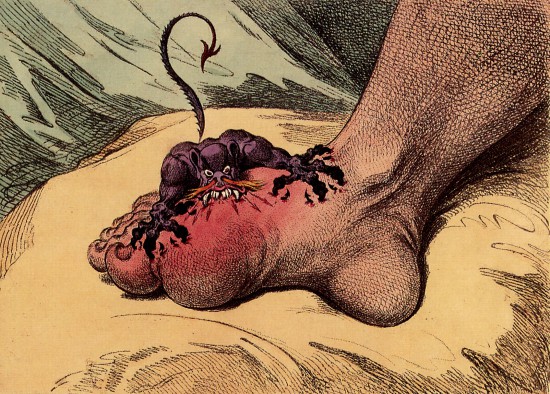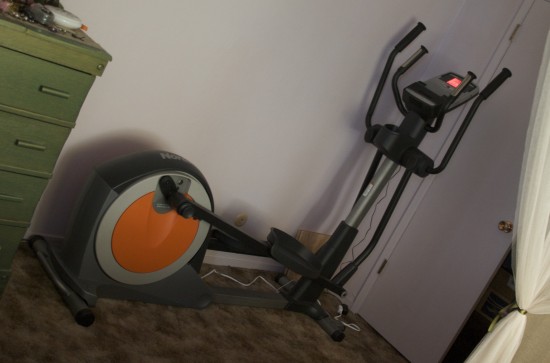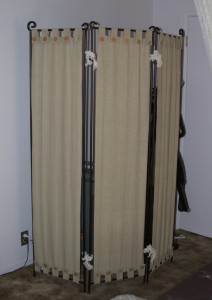The light of my life and I bought a fancy elliptical trainer a couple of years ago. She has been very consistent with it, while I’ve been, well, streaky. There are times I come home from work and I’m just too wiped out to contemplate getting on the thing. (On days I do manage to get up on it, I’m glad I did, but that lesson is soon forgotten.) I’m definitely healthier, but I’m no skinnier. In fact, I’m bigger than ever.
The obvious answer, of course, is to climb up on that bad boy first thing in the morning, before I’ve had time to start making excuses. Alarm goes off (dreadfully early), I drag my sorry ass out of bed and grind out my time. So far, I’ve been very consistent with this approach, and I think I arrive at work more alert and cheerful. And hungry. Gotta love the oatmeal bar at the little coffee place in the building. More on the hunger shortly.
One thing I have observed about working out first thing in the morning: It’s much harder to meet my goals. I’m going into max energy burn after fasting for a few hours, and I hit the proverbial bottom of the tank way sooner that I do when I work out in the evening. I’ve had to adjust my expectations accordingly.
I did some research to see if there was some food I could eat only moments before exercising that could help me power through. Turns out, not so much. But I did learn another interesting thing: What I eat right after I exercise can make a big difference next time. There is a window after exercise in which the body grabs all the energy it can out of the blood stream to convert to store in muscles as glycogen. Get the carbs (and some protein) rolling during that window and things will be better the next day. Pretty sweet!
I started comparing different foods for the right carb-protein balance (nonfat chocolate milk apparently is about perfect and has nutrients the commercial sports recovery drinks lack). I was about three days into this process when I started to wonder:
Isn’t it good when I run out of gas while working out? Isn’t that kind of the goal of all this?
All the advice I’d read, you see, was targeted at athletes. For them, high output while exercising is the goal. Not so much for me. I want to create conditions where my body (reluctantly) chooses to break down some of that stored energy in my fat cells and use that to restore the glycogen in my muscles. This process is far less efficient, and the human body really is loath to give up its precious fat, but during that same window where the body will suck every carb out of the bloodstream, if there aren’t enough carbs, it will convert just enough fat to keep things running.
My muscles aren’t replenished as much, and the next morning’s workout will be tougher. But ideally the energy is coming from the right place.
By the time I get to work, that window has closed, and my insides have returned to business as usual. And I’m about ready to eat an entire pizza. Hooray for oatmeal! It’s carb-heavy, but low-fat and sticks to the ribs and by lunchtime I’m able to make more sensible choices as well.
So, with such a sensible system, the pounds must be flying off, right?
Well, not so much. Not yet, anyway. I’m absolutely certain that I’m on the right track, and like any long-term project, it’s best to keep expectations of instant and dramatic success tempered. But I have recently made one more change, a dramatic, desperate gesture of good health beyond all reason.
I have a target weight this month. Next month, the target weight goes down. Each morning as I prepare to exercise, I step on the scales. If I’m above the target, no alcohol that day. No beer after work, no wine with dinner. I like beer and wine. While cutting alcohol will definitely reduce my caloric intake, there is a second, even more powerful, indirect effect. When the alarm clock goes off in the morning and I just want to stay in bed, I remind myself that shirking on my exercise will only delay my next sip of sweet beer. On days I don’t bring lunch from home I think about the consequences of eating the wrong thing: Another meal with my sweetie, with no wine for me.
A coworker laughed when I told him this story, imagining me on a treadmill running full-speed for a beer hanging just out of reach. That’s not far from the truth. But if it works, that’s all right with me.
 3
3
Sharing improves humanity:




